Daldinia concentrica (Xylariaceae) Crampball; Carbon Balls
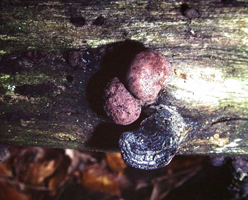 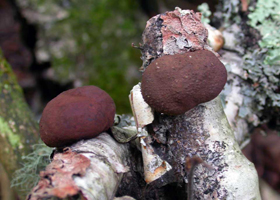 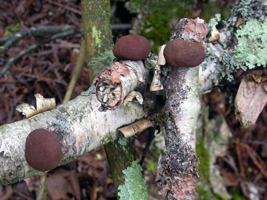
Grows gregariously on dead, fallen hardwoods, especially American Beech trees
Fruiting body – 2 to 2.5cm wide, 1.4cm thick, deep chocolate brown, finely powdered surface as seen with 10 X lens, dry, hard
Interior – black, brittle, composed of what appear to be concentric rings like tree growth rings
Spore print – black, but very difficult to obtain (took 2 days wrapped in a waxed bag to see spores, but not enough to examine with a microscope)
Comments: Found in late summer through fall; also seen at Whitefish Dunes State Park |
Dacrymyces palmatus (Dacrymycetaceae) Orange Witch’s Butter
 
Grows scattered to gregarious on dead conifers
Fruiting body – 1 to 3 cm wide, jelly soft when fresh, wrinkled, brain-like, red-orange and slightly translucent, hard when aged, tiny white basal attachment
Spores – Yellow, 16-23 x 6-8 microns, cylindrical to sausage shape, entire, becoming 8 to 10 celled
Comments: This fairly common species in conifer woods grows from late July to early October. It has also been seen at Mink River Preserve, Newport Park, the Ridges Sanctuary, Whitefish Dunes State Park and Peninsula Park. |
Dentinum repandum (Hydnaceae) Hedgehog Mushroom
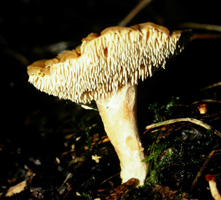 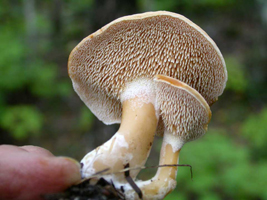
Grows solitary to scattered on soil in mixed woods
Cap – 2 to 5 cm, convex to nearly plane, medium orange to tan, dry, dull, no sheen, margin inrolled at first then wavy and upturned in age
Teeth – Decurrent, 3 to 9 mm long, whitish to pale tan, soft, slender, brittle
Flesh – White to yellowish, thick, mild odor
Stalk – 3 to 8 cm by 1 to 2 cm, central to off-center, concolor with cap
Spore print – White
Spores – 6.5 -9 x 5.5-8 microns, nearly round, entire
Comments: This species is infrequently found and they are usually small. It can be found growing from mid August to early October and has also been seen at Mink River, Newport Park, Ridges Sanctuary, Logan Creek and Washington Island.
|
Entoloma abortivum (Entolomataceae) Aborted Entoloma
 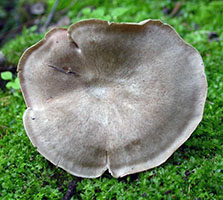 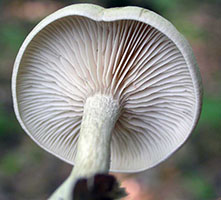
Grows scattered to clustered on buried wood or very rotted wood in mixed forests
NORMAL FORM
Cap – 3-8 cm, very broadly convex to plane in age, sometimes becoming concave, medium gray, dry
Stem – 3-4 cm by 11 -15 mm, apex gray and narrower, base wider and white, sometimes with a bulbous base
Gills – short decurrent, gray becoming pink with spores, close, broad
Flesh – gray-white, thick, nice odor like the aborted forms
Spores – pink-brown, irregularly angular, slightly roughened, 7.5-9 x 4.5-5.5 microns
ABORTED FORM
Has no cap, stem or gills, but is a rounded white fairly smooth to slightly flattened ball that appears chalky and has a slightly pink and firm interior when fresh; becomes soft and pithy as it ages.
Comments – Often only the aborted form is found and usually after the first autumn frost. This grows in September and October and has been seen in several county parks as well as Newport State Park, Whitefish Dunes State Park, Rock Island and on Washington Island. This is the only edible Entoloma; all others are poisonous. New evidence from DNA testing reveals that this may actually be an Armillaria that is being aborted by the Entoloma. Stay tuned. |
Entoloma lividum (Entolomataceae) Lead Poisoner
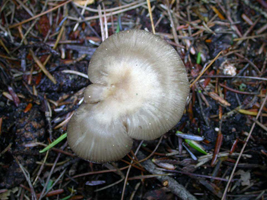 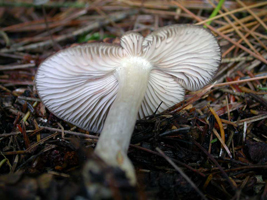
Grows single to scattered on soil in mixed woods
Cap – 3 to 8cm, broadly convex to plane, tan to medium-brown, smooth, slightly striate, hygrophanous
Gills – sinuate to adnexed, very pale tan to pinkish in age, close, broad
Flesh – white, thick in center only, putrid odor when cut
Stalk – central, cylindrical, 4 to 7cm by 7 to 12mm, smooth to finely fibrous-striate, white to very pale gray, pithy to hollow
Spore print – dull rose pink
Spores – angular but rounded, smooth, 7-9x6-7.5 microns
Also known as Entoloma sinuatum
Found in late summer to fall; also seen at the Ridges Sanctuary, Whitefish Dunes State Park and Rock Island State Park. |
Entoloma quadratum (Entolomataceae) Unicorn Mushroom
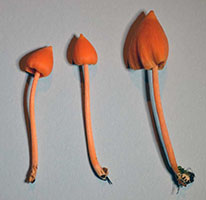 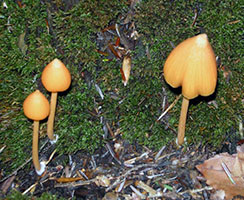
Grows scattered on soil under white pines
Grows scattered in moss on rotting wood under conifers or sometimes in mixed woods
Cap – 1.5-2.5 cm tall by 1-2 cm wide, medium orange to orange-brown, striate-grooved, bell-shaped, small nipple-like umbo, dry
Stem – 4-10.5 cm by 2-2.5 mm wide, central, cylindrical, same color as cap, pruinose apex, rest is smooth, brittle, fragile, pithy to hollow, white base
Gills – adnexed to nearly free or sinuate, deep orange, close to sub-distant, very broad, margins slightly wavy or scalloped
Flesh – very thin
Spores – pink to orange-tan, unequallateral squares, some five-sided, some have oil drop, 9-11 microns
Comments – These have been seen from mid-August to mid-September and have been found at Whitefish Dunes State Park and on Washington Island. Some books call this Salmoneum quadratum or Nolanea quadrata. |
Entoloma sericeum (Entolomataceae) Silky Pink Gill
 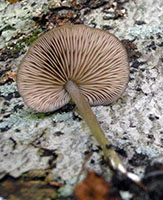 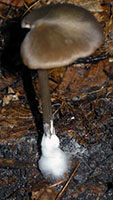
Grows scattered on soil under white pines
Cap – 2.5-6 cm, broadly convex, faint umbo, margin down curved, medium chocolate brown to gray-tan, satiny sheen, dry, faintly striate, hygrophanous
Stem – 5-9 cm by 4-9 mm, central, cylindrical, whitish-tan, white pruinose apex, smooth, fibrous-striate, pithy to hollow, white interior, white basal tomentum
Gills – adnexed to nearly free, close to sub-distant, dull pink, broad
Flesh – white to tan, thin, unpleasant odor
Spores – deep pink to rose-brown, angular, smooth, 7-11 x 5-8 microns
Comments – This was seen in early September to early October and was found at Toft Point, Whitefish Dunes State Park and the Mink River Preserve. |
Flammulina velutipes (Tricholomataceae) Velvet Foot
 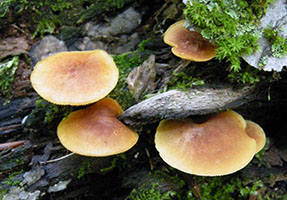 
Grows scattered to clustered on dead or living hardwoods in mixed woodlands
Cap – 3-4 cm, very broadly convex, rich yellow-brown with a darker low umbo, striate, shiny, viscid
Stem – 4 cm by 3 mm, central, curved, dark chocolate brown, velvety texture, tough, hollow
Gills – sinuate, dull yellow, sub-distant, intervenose, broad, browning in age or where bruised
Flesh – rich yellow brown, medium thick
Spores – white, non-amyloid, elliptical, smooth, 7-9 x 3-5 microns
Comments – This is usually a cold weather fungus but it has been found near Lake Michigan at Whitefish Dunes in July and at Logan Creek in the middle of September. |
Fomes fomentarius (Polyporaceae) Horse’s Hoof
 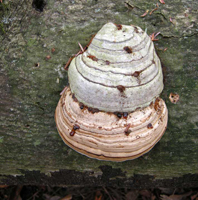 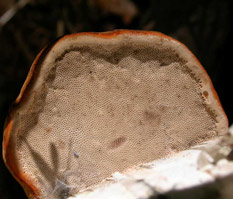
Grows solitary to scattered on standing or fallen birch trees and other hardwoods
Cap – 6 to 8 cm wide by 3 to 5 cm deep and 3 to 4 cm thick, hoof shape, rich tan with darker narrow concentric bands when fresh, dry, smooth to minutely felty when seen through a 10 X lens, caps fade to light gray in age and can stay on trees for several years; no stalk
Pore surface – Gray tan, round, 3 per mm, tubes up to 1.5 cm long, single layer
Flesh – Medium orange brown, thin compared to the tube length, firm
Spore print – White, but very difficult to obtain
Spores – 15-20 x 4.5-7 microns, cylindrical, entire
Comments: The Horse’s Hoof is one of the most common species in our area and can be found actively growing during the warm late summer to early fall. It has been seen at Mink River, Newport Park, Kangaroo Lake Preserve, The Clearing Folk School, Ridges Sanctuary, Peninsula Park, Logan Creek, Potawatomi Park, Whitefish Dunes and Rock Island. It can be seen in all seasons as it is perennial and will stay on trees for several years. |
Fomitopsis cajanderi (Polyporaceae) Rosy Polypore
 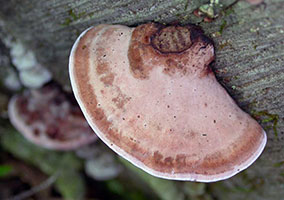 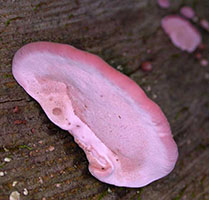
Grows scattered on dead fallen conifer trees
Fruiting body – 5-10 cm wide by 3.5-6 cm deep, shelf-like & 1-2 cm thick where attached, sometimes growing resupinate-reflexed, top has dark brown base, tan-brown center, orange-brown bands with a tiny white outer margin, underside is pink
Pores – pink, tiny, round, 4-5 per mm,
Tubes – 2-5 mm deep, one layer
Flesh – pinkish to dark brown, 5-7 mm thick
Spores – clear or white, elliptical, smooth, 7-8 x 2 microns
Comments – This was first seen in early to mid-September at Whitefish Dunes State Park and also found at The Ridges Sanctuary in mid-October. |
Fomitopsis pinacola (Polyporaceae) Red-banded Conk
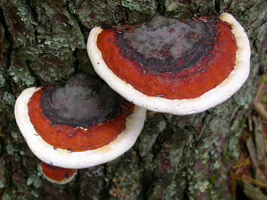 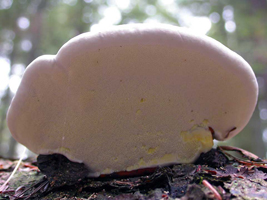
Grows solitary to scattered on dead or dying conifers
Cap – 10 to 16 cm wide by 8 cm deep, semicircle to fan shaped, gray center, narrow black band next, red outer band, thickened rounded outer whitish margin, crusty surface; no stalk
Pore surface – White, angular, 3 to 5 per mm, bruising yellow, tubes 3 to 5 mm long, distinct layers, turn brown with age
Flesh – White to pinkish buff when young, very tough and woody, pale brown in age
Spore print – White to pale yellow
Spores – 5-8 x 3.5-5 microns, elliptical, entire
Comments: This species had only been reported at Toft Point for many years before finding it at the Logan Creek Preserve in October 2010. It is perennial and can be seen in all seasons. |
Galerina marginata (Strophariaceae) Deadly Galerina
 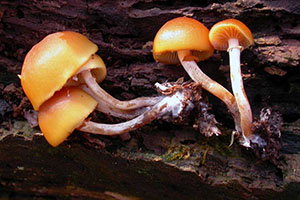 
Grows scattered to clustered on dead rotting fallen hardwoods and conifers
Cap – 1-4 cm, broadly convex to plane in age, medium yellow-brown, smooth, sometimes slightly striate, tacky, hygrophanous
Stem – 3-5 cm by 3-5 mm, central, cylindrical, sometimes curved, superior slight ring or ring zone of small brown fibers, tan apex above ring, medium brown & fibrous-striate below ring, pithy to hollow
Gills – adnate to slightly decurrent, close, medium tan, broad
Flesh – tan, medium thick, acrid odor or sour smell
Spores – chocolate brown, elliptical to football shape, entire but roughened, 7-11 x 5-6 microns
Comments – These have been seen through most of September and October and were found at The Clearing woods, The Ridges Sanctuary, Mink River Preserve, Whitefish Dunes, Logan Creek, Newport State Park and the Kangaroo Lake Land Trust Preserve. |
Ganoderma applanatum (Polyporaceae) Artist’s Conk
 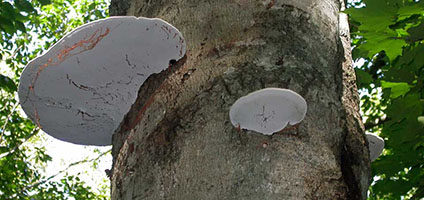  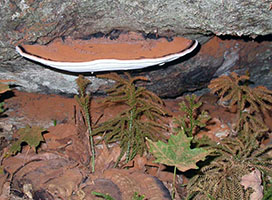
Grows shelf-like on standing or fallen rotting hardwoods and conifers and is perennial
Fruiting body – 5-25 cm or more by 5-15 cm, pale brown in youth but turns darker brown with a dry un-varnished crust-like top, can become dusted with medium brown spores in age, concentric bands of ridged “growth rings”
Underside – pores white to grayish-white, round, tiny, 5-6 per mm, bruises dark brown with injury
Tubes – up to 1 cm deep, multilayered, tough
Flesh – 7-10 mm thick, deep yellow brown to rust brown in age
Spores – medium brown, oval, double-walled and truncate and appearing tuberculate, 7.5-10x-6-8 microns
Comments – This very common woody mushroom can be found in every state in our country and probably in every month. It can grow to enormous size and last many years on a tree. It has been found at Whitefish Dunes State Park, Mink River Preserve, Kangaroo Lake Land Trust Preserve, Newport State Park Rock Island, Peninsula State Park and many other county parks. |
Ganoderma tsugae (Polyporaceae) Hemlock Polypore
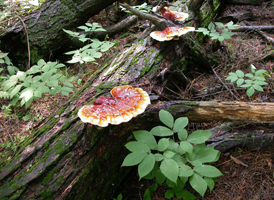 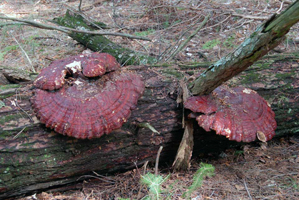  
Grows solitary to scattered on dead hemlock trees
Cap – 5 to 30 cm wide, fan shape to kidney shape, red brown shiny and polished or varnished looking when actively growing, zoned and furrowed, fades a bit and becomes dull as it ages
Pore surface – White when fresh turning brown with age, 4 to 6 pores per mm, round to angular, tubes 3 to 10mm long
Flesh – White, 5mm to 3 cm thick
Stalk – (when present) Lateral, 2 to 10 cm long by 1 to 4 cm thick, red varnished like cap, smooth surface
Spore print – Brown
Spores – 9-11 x 6-8 microns, elliptical, blunt at one end, double-walled
Comments: This is uncommon being seen only in hemlock woods, actively grows from mid summer to September, but is perennial and can be seen in all seasons. It has also been seen at Whitefish Dunes Park. |
Geastrum saccatum (Geastraceae) Rounded Earthstar
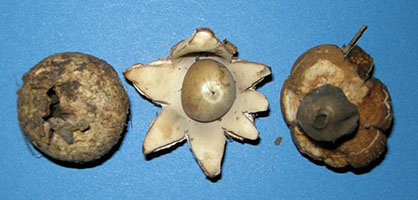 
Grows single to scattered on soil in late summer into early fall and can be found in gardens
Fruiting body – unopened it is a 2.5 cm ball; opened with rays peeled back it can attain 3.5 cm diameter by 1.5 cm tall, usually with 7 rays, inner ball is 1.5 cm wide, medium dark tan, stalkless, opening at top has a few hairs and a 5 mm wide pale tan area surrounding it
Spores – dark brown to black, round, spiny, 3.75-4.5 microns
Comments – I have found this only once in a friend’s garden near Baileys Harbor in mid-October of 2014. In early fall 2016 someone else sent a photo of one in their garden not far from Cana Island. |
Geastrum triplex (Geastraceae) Saucered Earthstar
  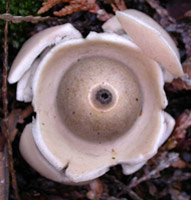
Grows solitary to scattered on humus under hardwoods
Fruiting body – 5 cm diameter with rays extended, 2 cm wide ball on saucer-like plate attached to center of extended rays, aperture has black fibers radiating around it and is ringed with a halo about 8 mm in diameter
Spores – Black, 3.75-4.5 microns, round, spiny
Comments: This fairly common species grows from early September to mid October and has also been seen at the Bjorklunden property, Death’s Door Bluff County Park, Rock Island and Whitefish Dunes State Park. |
Geoglossum difforme (Geoglossaceae) Tall Black Earth Tongue
 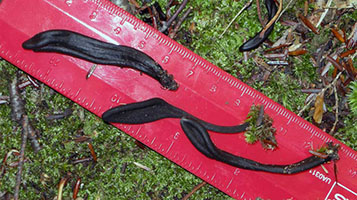
Grows scattered to gregarious on soil and in moss under conifers or mixed woods
Fruiting body – 4-7.5 cm tall, head is 2 cm tall by 1 cm wide, black, smooth to fine glistening particles as seen with 10 X hand lens, interior is black
Stalk – 2.5 cm by 2 mm, black, scurfy near apex, rest is smooth
Spores – black, long & narrow, slightly curved like a banana, smooth, 95-115 x 5-10 microns, 15-septate
Comments – This can be found from August to October and has been seen at the Ridges Sanctuary, Newport State Park and Rock Island. |
Geoglossum fallax (Geoglossaceae) Deceptive Black Earth Tongue
  
Grows single to scattered in moss, on soil or on well-rotted wood in mixed conifer and hardwoods
Fruiting body – 4-6 cm tall, head –2-2.5 cm tall by 3-7 mm wide, black to very dark brown, smooth, long spatula shape with center vertical groove, dry hairless
Spores – clear or brown in microscope, long sausage, 7-septate, numerous hyaline spores seen were non-septate, 75-95 x 6-10 microns
Comments – This can easily be overlooked as it blends in well with the dark forest ground. It has been found in The Ridges Sanctuary and the Mink River Preserve from August into October. |
Gloeophyllum sepiarium (Polyporaceae) Rusty-gilled Polypore
 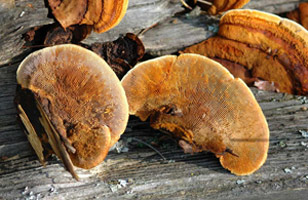
Grows solitary or grouped on dead conifers
Cap – 3 to 10 cm wide by 2 to 4 cm deep, semicircle to fan shaped, concentric bands, outer band rich orange and pitted, next two bands slightly duller orange and appressed-furry, inner two bands deep brown and wider than others; no stalk
Pore surface – Radiating light to medium orange brown ragged-edged gills, 4 mm deep by 1 mm apart, firm
Flesh – Dark rust similar to two inner bands on cap, 3 mm thick, soaks up water like a sponge
Spore print – White
Spores – 7-11 x 3-4 microns, clear, elliptical to sausage shape, entire
Comments: This fairly common species is found growing from early August to late October. It has also been seen at The Ridges Sanctuary, Whitefish Dunes and far southeast Door County near Lake Michigan. |
Gomphidius glutinosus (Gomphidiaceae) Slimy Gomphidius
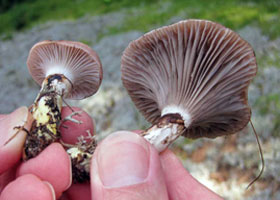 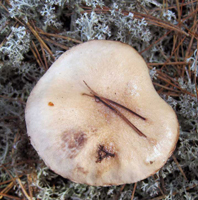 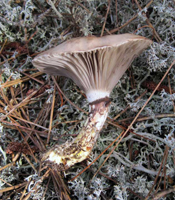
Grows scattered on soil in beds of Reindeer Moss Lichen (Cladonia rangiferina)
Cap – 3 to 5cm, broadly convex to nearly plane, flesh colored but not too pink, smooth, straight margin, tacky to viscid in wet weather
Gills – decurrent, close to sub-distant, pale gray in youth to black in age, broad, thick, even-edged
Flesh – pale pink-tan, thick, no odor
Stalk – central, cylindrical, 4 to 5cm by 7 to 10mm, tapers downward, small superior ring of raised fibers darkened by falling spores, apex white above ring, base bright yellow on lower half, fibrous-striate, tough, solid
Spore print – black
Spores – elliptical, smooth, 15-20x5-7.5 microns
New to Door County, found at Toft Point on September 14, 2013 |
Gomphus clavatus (Cantharellaceae) Pig’s Ears
 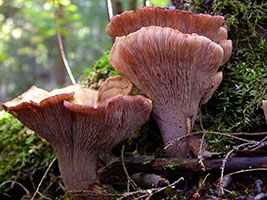 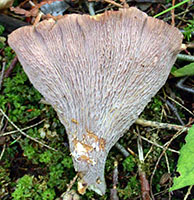 
Grows scattered to gregarious on soil under conifers
Fruiting body – 4-10 cm tall pale milk-chocolate brown with violet hues
Cap – 3-9 cm diameter at top, half funnel shape, medium pinkish-tan with a scurfy surface
Stem – 3-4 cm long by 1.5-2 cm thick, tapers downward, slightly off-center, whitish to tan, tomentose to smooth, interior is white, solid and chalk-like
Gills – decurrent, blunt, shallow, rib-like, sub-distant to close, faint grayish deep tan, intervenose
Spores – buff to pale yellow, non-amyloid, elliptical, tuberculate, 9-11 x 4-6 microns
Comments – It is interesting that I’ve only found this twice, both on October 1st, in 2006 at the Mink River Preserve and in 2014 at the Ridges Sanctuary. |
Gymnopilus liquiritiae (Cortinariaceae) no common name
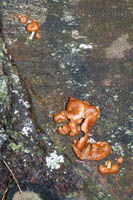  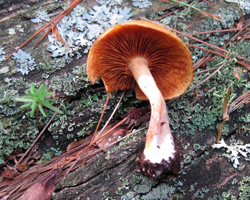 
Grows clustered on fallen or cut conifer logs
Cap – 1.5-3 cm, very broadly convex, orange-brown, hygrophanous, finely tomentose with flat fibers, incurved margin when young
Gills – Adnate to slightly sinuate, light orange-brown, close, very broad
Flesh – Medium-thick, yellow-tan, nice odor
Stalk – Central to off-center, 1.5-2.2 cm x 3-5 mm, light brown, smooth, pithy to hollow, not tough
Spore print – Rusty brown
Spores – Oval, tuberculate, average size is 9 x 6 microns
Comments: found along main road into Toft Point in October. |
Gymnopilus sapineus (Cortinariaceae) Scaly Rustgill
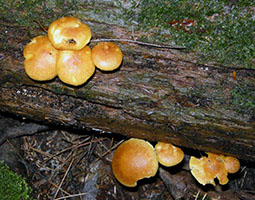 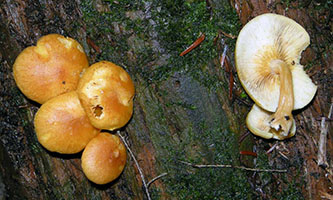 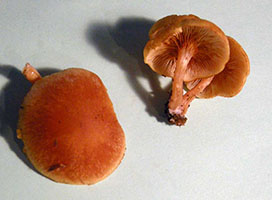
Grows single to cespitose on wood of rotting conifers
Cap – 2-7 cm, broadly convex, deep yellow brown, paler margin, shiny, slightly tacky, hygrophanous
Stem – 3-4.5 cm by 3-8 mm, central, cylindrical, light orange brown, tough, solid to pithy interior
Gills – sinuate to short decurrent, close to crowded, rusty orange
Flesh – medium thick, medium to dark tan, foul odor
Spores – rusty brown, fat oval, tuberculate, 7-9 x 4-6 microns
Comments – This has been seen growing from mid-August to late October in Whitefish Dunes State Park, Newport State Park, Toft Point and on private land. |
Gymnopilus spectabilis (Cortinariaceae) Big Laughing Gym
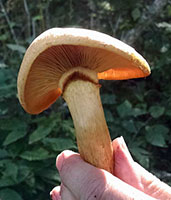  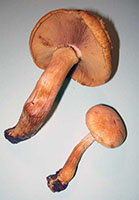 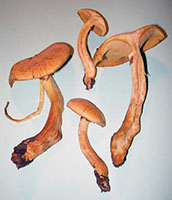
Grows scattered to clustered on dead conifer logs in mixed woods
Cap – 4-12 cm, broadly convex to plane in age, downcurved margin, medium yellow-brown to deep rusty brown, dry, tomentose
Stem – 5-10 cm by 1-2.5 cm, tapers upward, concolor, small superior ring flares in youth and may disappear in age, fibrous-striate, tough, cartilaginous, pithy to hollow
Gills – sinuate, close, tan to rusty brown, medium broad
Flesh – rusty brown, medium thick, nice odor but very bitter taste
Spores – chocolate to rusty brown, oval, tuberculate, roughened, 6-9 x 4-6 microns
Comments – This has been seen from late July through September at The Clearing woods, Whitefish Dunes State Park, Potawatomi State Park and Washington Island. Recent DNA analysis gives it the new species name of junonius. |
Gymnopus dryophilus (Tricholomataceae) Oak-loving Collybia
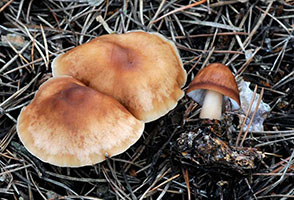 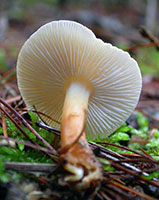  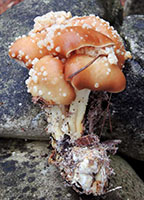
Grows single, scattered or clustered on soil or in moss under pines and in mixed woodlands
Cap – 2-6 cm, hemispheric in youth to very broadly convex, medium orange-brown but paler near the straight margin, smooth, dry, hygrophanous, sometimes decorated with another jelly-like fungus called Collybia Jelly (Syzygospora mycetophila)
Stem – 2-7 cm by 3-15 mm, central, cylindrical, apex colored like cap margin, base colored like cap center, smooth, sometimes with a slightly bulbous base coated with cottony hairs, hollow, fragile
Gills – adnexed to adnate, close to crowded, pale tan, medium broad
Flesh – white to pale tan, medium thick
Spores – white, non-amyloid, elliptical, smooth, 5-7 x 3-4 microns
Comments – This is a fairly common species seen from July to November at The Ridges Sanctuary, Whitefish Dunes State Park, Mink River Preserve, Newport State Park, DC Land Trust Canal Property, Toft Point and Washington Island. The old name was Collybia dryophila. |
Gyromitra esculenta (Helvellaceae) False Morel
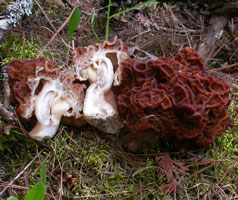 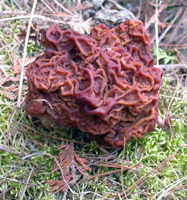 
Grows single to scattered on soil in conifer and mixed woods
Cap – 7-9 cm tall and 7-10 cm wide, Wrinkled unevenly, medium-dark milk chocolate brown on tom and lighter tan-brown on lower part of cap, smooth surface, not hairy.
Stalk – 5 cm x 2-3 cm wide, smooth but dented in parts, medium tan, interior is chalky pale tan and is part solid and part hollow.
Flesh -- brittle
Spore print -- clear
Spores – Elliptical, smooth, non-amyloid, 15-20 x 9-11 microns
Comments: Found in open shrubby wooded areas not far from Mud Bay usually in May. |
Gyromitra fastigiata (Helvellaceae) Thick-stalked False Morel
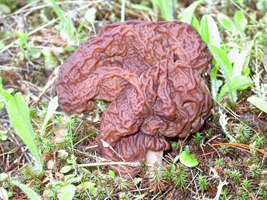
Grows solitary to scattered on soil under hardwoods and in open woods
Cap – 3 to 4 cm tall by 4 to 6 cm wide, caramel to dark brown, brain-like lobes and irregular folds, no pits as in the true morel
Flesh – partly hollow and partly solid inside, tan
Stalk – 4 cm tall by 3 to 4 cm wide, white, often terete, interior partly solid and partly hollow
Spores – Clear, 30-38 x 11-13.5 microns, spindle-shaped with one well-developed knob on each end and one large oil drop inside
Comments: Grows in May and has also been seen at Whitefish Dunes State Park. |
Gyromitra infula (Helvellaceae) Hooded False Morel

Grows solitary to scattered on humus or on well-rotted logs in mixed woods
Cap – 4 to 8 cm tall by 3 to 7 cm wide, saddle shaped or lobed, incurved edge, red brown to dark brown or yellow brown, smooth, not wrinkled or brain-like
Flesh – Thin and brittle
Stalk – 3 to 4 cm tall by 1 to 2.5 cm wide, light tan, tapers upward, smooth, not chambered nor ribbed
Spores – Clear, 15-22 x 6-9 microns, broadly elliptical, entire, two oil drops inside
Comments: It grows from mid September to early October and has also been seen at the Mink River Preserve and Newport Park. |
Gyroporus cyanescens (Boletaceae) Tan and Blue Bolete
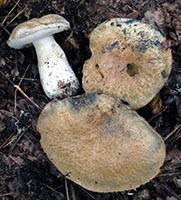 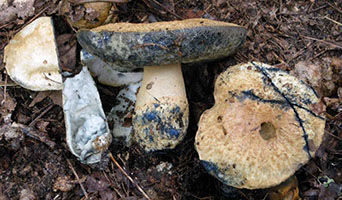 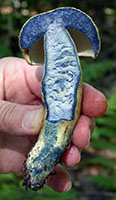
Grows single to scattered on sandy soil or in grass in mixed hardwoods
Cap – 4-10 cm, broadly convex to plane in age, yellow-tan, tomentose-wooly surface, bruises blue quickly when injured
Stem – 5-8 cm by 1.5-3 cm, central, club-shaped to ventricose, apex wooly, base slightly tomentose, yellow-tan, bruising blue when cut, fragile, becoming hollow
Pores – 1-3 per mm, pale yellow
Tubes – depressed-attached, up to 8mm long, turn blue rapidly when cut
Spores – brown, elliptical, smooth, 7-11 x 4-6 microns
Comments – This is not very common having been found only four times since 1993 mostly in September and October at Newport State Park and Whitefish Dunes State Park. It is fragile and the instant change from tan to deep blue when cut is dramatic. |
Hebeloma hiemale (Strophariaceae) no common name
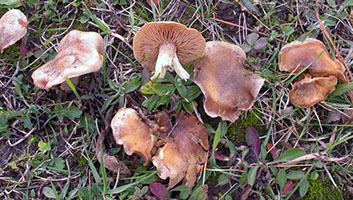 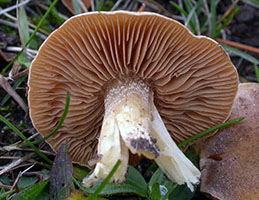
Grows gregariously to clustered in grass in mixed woods
Cap – 2-5 cm, broadly convex with a low broad umbo, viscid, light to medium brown, smooth
Stem – 2-2.7 cm by 5-8 mm, central, cylindrical, light tan, fibrous, pithy, splits easily, white powdery apex
Gills – adnate to sinuate, medium brown, close, broad, edges are minutely fringed with white
Flesh – white, thin, odor mild but not radish-like
Spores – medium brown, almond-shaped with point at one end, entire but roughened, 11-15 x 5-7.5 microns
Comments – This was found only on private land in mid to late October. |
Hebeloma mesophaeum (Strophariaceae) Veiled Hebeloma
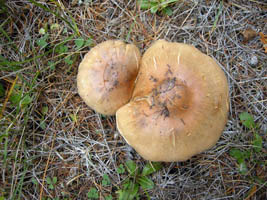 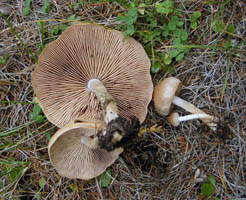
Grows scattered to gregarious on soil and in grass under conifers
Cap – 2-8 cm, hemispheric to very broadly convex, medium brown center and tan margin, smooth to slightly pruinose, slightly tacky, young cap has cortina-like veil
Gills – Adnexed, tan, close, broad, margins are white-edged
Flesh – Medium-thick, medium-brown, mild nice odor
Stalk – Central, cylindrical, 4-7 cm x 3-8 mm, shiny, tan, tough, fibrous-striate, white powdery apex, dark brown base, bits of veil on surface, pithy to hollow
Spore print – Light brown
Spores – Football shape, entire but roughened, no apical pore, 9-11 x 4-6 microns
Comments: found in October to early November |
Hebeloma sinapizans (Strophariaceae) Scaly-stalked Hebeloma
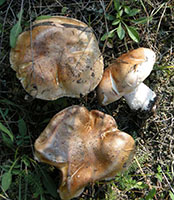  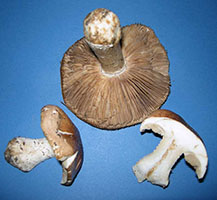
Grows scattered to gregarious on soil or in grass under conifers or hardwoods
Cap – 4-12 cm, broadly convex to plane in age, tan to medium brown, appressed hairs, tacky
Stem – 4-7 cm by 1-2.5 cm, central, clavate-bulbous, white to pale tan, shaggy fibrous, tough, solid to pithy, cartilaginous
Gills – sinuate, pale tan to medium brown, close, broad
Flesh – white to light tan, thick, strong radish odor
Spores – milk chocolate to cinnamon brown, pip-shaped to football-shaped, tuberculate, 11-15 x 6-8 microns
Comments – This was first found in October 1983 and then not until October 2002 and the next time in October 2014, so it is not common or widespread. It was seen on private land and at the Land Trust’s Three Springs Preserve. |
Helminthosphaeria clavariarum (Helminthosphariaceae) Gray Coral Mold
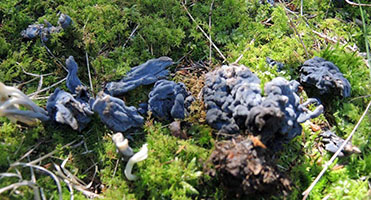 
Grows as a parasite on the coral mushroom Clavulina cristata from the base upward
Fruiting body – begins at the base of Clavulina cristata and is a purple-gray mold encompassing the coral, often found in low wet places or in wet weather conditions.
Spores – white, amyloid, spindle-shaped or football-shaped, smooth 10-14 x 5-6.5 microns
Comments – This was seen on private land in mid-September 2014, a very wet month. I had to go online to find it as few mushroom field guides listed it. It is mentioned in Coker’s guide to the Clavariaceae. |
Helvella crispa (Helvellaceae) Fluted White Elfin Saddle
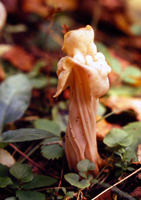 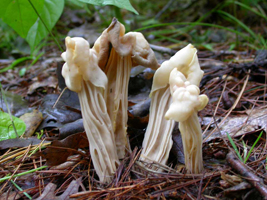 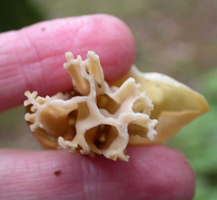
Grows solitary to scattered on soil in mixed woods
Cap – 4 cm tall by 3 to 4 cm wide, saddle shaped to lobed, pale tan, margin inrolled at first becoming flared and wavy in age, sterile undersurface scurfy to finely hairy
Flesh – Thin and brittle
Stalk – 5 cm tall by 12 to 18 mm wide, concolor, deeply ribbed and fluted, equal or tapering upward, chambered in cross-section
Spores – White to clear, 17-22 x 13-16 microns, large oval, entire
Comments: This uncommon species grows from early September to late October and has also been seen at Newport Park and Whitefish Dunes State Park. This is the first wild mushroom I ever photographed at Toft Point in October 1971. |
Helvella elastica (Helvellaceae) Brown Elfin Saddle
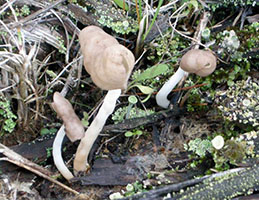 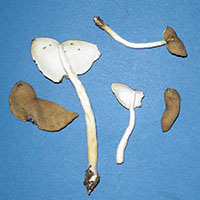 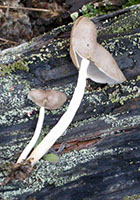 
Grows scattered on soil in mixed hardwoods and conifers
Cap – 2-3.5 cm wide by 2 cm high, folded saddle-like over top of thin stem, light brown to grayish brown, margin slightly incurved and sometimes fused to other side of saddle, smooth
Underside – light gray, smooth, no hairs
Stem – 5-11 cm by 4-8 mm, white, central, slightly flattened, smooth, tapers upward, fragile, hollow
Spores – white or clear, fat oval smooth, no oil drops seen, 17-22 x 10-18 microns
Comments – This is not common having been seen only at the Ridges Sanctuary, Whitefish Dunes State Park and Three Springs Preserve in September and October on four occasions over a period of 22 years. |
Helvella lacunosa (Helvellaceae) Fluted Black Elfin Saddle
 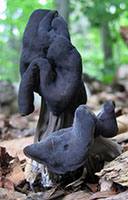
Grows single to scattered on wood chips or soil in mixed woods
Fruiting body – 3-6 cm tall
Head – 1-4 cm high by 2-4 cm wide, gray-brown to black, contorted saddle shape, smooth, margin sometimes attached to stem, dry, underside is gray
Stem – 4-5 cm by 1.7 cm, straight, fluted and pocked by holes, pale gray with white base
Spores – clear, fat oval, smooth, 16-19 x 12-13 microns
Comments – First seen in September 1984 in a Clearing class, then not seen until 2002 and then in 2013, so it is not common. It was seen once at Whitefish Dunes State Park and once in the garden area of Bjorklunden. |
Helvella subglabra (Helvellaceae) no common name
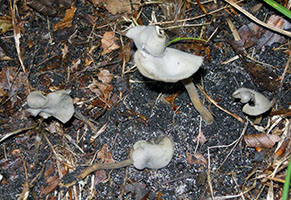 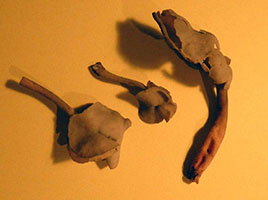
Grows scattered on soil in mixed woods
Cap – 2-5 cm wide by 2-4 cm tall, flattened contorted disk folded against the stem, dull brownish-gray, smooth, attached to top of stem and by a tiny “arm” part way down
Underside – smooth and a bit paler gray
Stem – 4-8 cm by 3-8 mm, terete, brown, smooth, tough, solid to stuffed, brittle
Spores – clear, non-amyloid, fat oval, smooth, 15-19 x 9-12 microns
Comments – This was seen only once on Rock Island in early October 2016 |
Hericium americanum (Hydnaceae) Bear’s Head
 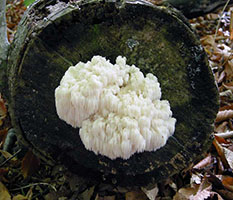 
Grows single to scattered on live or dead hardwoods and rarely on conifers
Fruiting body – A white mass of densely branched “spines” or icicle-like teeth, 10-25 cm in diameter, spines 1-4 cm long, attached by a solid base, turning yellowish in age
Spores – white, nearly round, amyloid, smooth, 5-7 microns
Comments – This is a spectacular mushroom when pure white and very fresh. Name changes over the years may show the species coralloides in older field guides. |
Hericium coralloides (Hydnaceae) Comb Tooth
 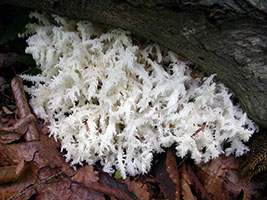 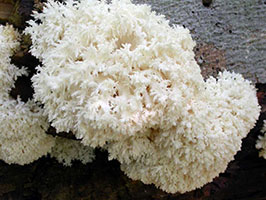
Grows scattered to gregarious on live or dead hardwoods in mixed woodlands
Fruiting body – A white delicately branched mass arising from a single base, 10-20 cm wide, spines in rows and less than 1 cm in length often only 3 to 5 mm, branches densely packed together, yellowing in age
Spores – white, amyloid, nearly round, smooth, 3-4 microns
Comments – This is a more delicate species than americanum and a delight to find on a hike in the woods. It can be found from July to October and has been seen at the Mink River Preserve, Whitefish Dunes, Logan Creek Preserve and Rock Island. Older field guides will have the species name ramosum. |
Hericium erinaceus (Hydnaceae) Old Man’s Beard
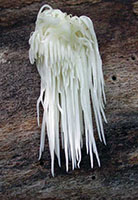 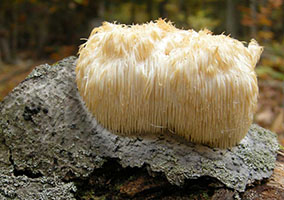
Grows usually on live or dead hardwoods as a single mass
Fruiting body – large oval solid mass of spines 3 to 6 cm long, no branching, more compact than other Hericium species, pure white, yellowing in age, mild odor
Spores – white, amyloid, round, smooth, 4-6 microns
Comments – This has been seen mostly in September and October at Whitefish Dunes State Park, Logan Creek Preserve, Mink River Preserve, Peninsula State Park and Newport State Park. |
Humaria hemisphaerica (Pyronemataceae) Hairy Fairy Cup
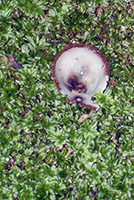 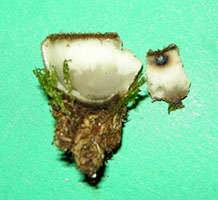 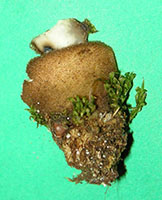
Grows single to scattered on well-rotted wood or in moss in mixed hardwoods
Fruiting body – small cup, 1-3 cm, with whitish to pale gray smooth interior and fuzzy exterior of short brown hairs
Spores – clear, big oval, tuberculate, 22-25 x 11-16 microns
Comments – This is usually difficult to find as it is quite small and can blend in with its woodland surroundings. It has been found from late July to mid-October at Newport State Park, Toft Point and Rock Island. |
Hydnellum scrobiculatum (Bankeraceae) Rough Hydnellum
 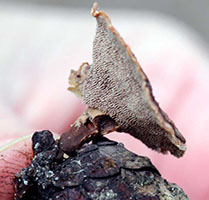
Grows single to scattered on sandy soil under conifers
Cap – 2.5-7 cm, flat to slightly concave, orange brown to dark brown, zonate, radially concentric bands, paler margin, tomentose to covered with short projections (like aborted caps)
Stem – 2-6 cm by .5-3 cm wide, medium rose brown to very dark brown, smooth to suede-like, solid dark brown interior
Underside – medium chocolate brown teeth that are 2-4mm long, 3-4 per mm, decurrent, outer tan sterile margin
Flesh – dark brown, medium thick, dense
Spores – gray-brown, rough angular to oblong, bumpy-tuberculate, 5-6 x 3-4 microns
Comments – This tough mushroom has been found in September at The Ridges Sanctuary, Washington Island and on private land. |
Hydnellum zonatum (Bankeraceae) Zoned Hydnellum
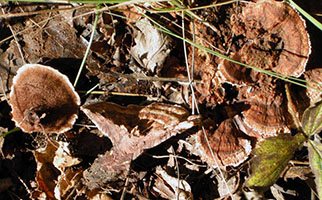 
Grows single to scattered on soil in mixed woods and shrubs in old fields
Cap – 3-11 cm, shallow funnel to nearly plane, rich medium brown with darker brown concentric bands, surface covered with rough points only in center, matted fur on most of top, paler tan margin
Stem – 2 cm by 1 cm, tapers downward, dark brown
Underside – dark brown teeth are 2-3 mm long, paler sterile margin
Flesh – dark brown, tough, medium thick
Spores – gray-brown, elliptical to nearly round, strongly warted and hard to measure, 3.5-5.5 x 3.5-4.5 microns
Comments – These were found in an old field near a mixed conifer hardwoods section of the Land Trust’s Kangaroo Lake Preserve in early October. |
Hygrocybe autoconica (Hygrophoraceae) Acute Conic Waxy Cap
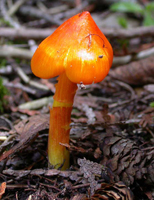
Grows scattered on soil in mixed woods
Cap – 3 to 4 cm, conic with a definite point, orange-yellow, smooth, sometimes with a radially scalloped uplifted margin, color fades in age but never blackens
Gills – Adnexed to nearly free, pale yellow, broad, close, gill tissue parallel
Flesh – Yellow, thin, waxy
Stalk – 5 to 6 cm by 5 to 7 mm, central, cylindrical, slightly striate, hollow
Spore print – White
Spores – 9-14 x 6-8 microns, oval, entire
Comments: This small waxy cap can be confused with Hygrocybe conica, but does not blacken with handling or in age. It grows from early August to mid October but is not very common and has also been found at the Mud Lake State Wildlife Area, Newport State Park, Logan Creek Preserve, the Ridges Sanctuary and Whitefish Dunes State Park. |
Hygrocybe cantharellus (Hygrophoraceae) Chanterelle Waxy Cap
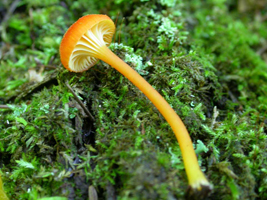 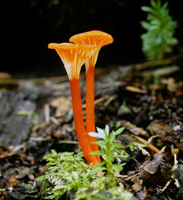
Grows widely scattered on soil in mixed woods
Cap – 1 to 2.5 cm, bright orange, broadly convex to concave in age, dry to slightly powdery surface
Gills – Decurrent, orange, broad, close
Flesh – Chrome yellow, thin
Stalk – 3.5 to 7 cm by 3 to 5 mm, bright orange like cap, central, cylindrical, smooth, hollow
Spore print – White
Spores – 7-11 x 4-7 microns, oval, entire, non-amyloid
Comments: This is a gorgeous small mushroom with beautiful color and shape but is never abundant. It is found from mid July to early October and also seen at Meridian County Park, Mink River Preserve, The Ridges Sanctuary and Whitefish Dunes State Park. |
Hygrocybe coccinea (Hygrophoraceae) Deep Red Waxy Cap
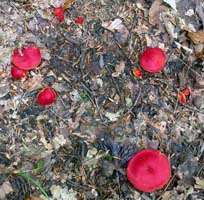 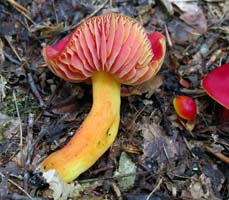
Grows scattered to gregarious on soil in mixed woods
Cap – 1-5 cm, broadly convex to slightly concave in age, margin down curved in youth, blunt conic to rounded umbo, scarlet red, finely tomentose to smooth, slightly tacky
Stem – 3-6 cm by 2-9mm, central, cylindrical, deep orange to light red, paler apex, white base, smooth, striate, pithy to hollow, brittle
Gills – adnate to adnexed to nearly free, yellow-orange, intervenose, sub-distant, broad
Flesh – red-orange, thin
Spores – white, non-amyloid, elliptical, smooth, 7-11 x 4-6 microns
Comments – This can be seen in September and October and has been found on Rock Island, Washington Island, Newport State Park, Bjorklunden woods and the Kangaroo Lake land Trust Preserve. |
Hygrocybe conica (Hygrophoraceae) Witch’s Hat
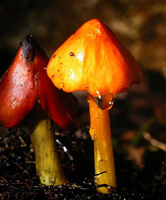
Grows single to widely scattered on soil in mixed woods
Cap – 2 to 4 cm, conic and pointed to broadly conic, usually retaining the pointed umbo, deep red-orange, smooth, turning black with age or bruising
Gills – Adnexed to nearly free, broad, thick and waxy, yellowish to white, blackening in age
Flesh – Yellow, thin, waxy and blackening with age or bruising
Stalk – 6 to 8 cm by 4 to 12 mm, brilliant yellow-orange with white base, vertically striate, bruising black, hollow
Spore print – White
Spores – 9-11 x 4-7 microns, oblong, entire, non-amyloid
Edibility – Too small and flavorless
Comments: This distinctive mushroom is easily recognized by its tendency to turn black with handling or in age. It is fairly common from mid July to late September and can also be found at The Ridges Sanctuary, Mink River Preserve and Newport State Park. |
Hygrocybe cupsidata (Hygrophoraceae) Fading Conic Waxy Cup
 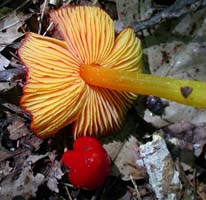
Grows single to scattered on soil in mixed woods
Cap – Deep bright red, conic in youth to nearly plane in age, pointed umbo, fades to orange-red in age, viscid, margin splits in age
Stem – 4-9 cm by 5-10 mm, central, cylindrical, light orange, white base, smooth, striate to slightly twisted, cartilaginous, pithy to hollow
Gills – adnexed to nearly free, light to medium orange, close, very broad
Flesh – orange-red, very thin
Spores – white, non-amyloid, elliptical, smooth, 8-11 x 5-7 microns
Comments – This can be seen from early July to mid-September and has been found at Newport State Park and on private land. |
Hygrocybe laeta (Hygrophoraceae) Pinkgill Waxy Cup
 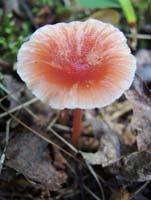
Grows scattered to gregarious on sandy soil in mixed woods
Cap – 2-3.5 cm very broadly convex to concave in age, dull rosy pink, margin is pink-tan, darker disk, smooth and shiny but not striate, it is viscid and the stickiest agaric I have ever handled
Stem – 4-6 cm by 3-6 mm, central, cylindrical, apex is light pink, rest is pale yellow, smooth, extremely sticky, hollow, brittle, fragile
Gills – short decurrent, pale pink to tan, sub-distant, broad
Flesh – deep pink to pink-tan, very thin
Spores – white, non-amyloid, elliptical, smooth, 6-8 x 4-5 microns
Comments – This was found on 9-7-14 on the land Trust Canal Property. |
Hygrocybe marginata (Hygrophoraceae) Orange-gilled Waxy Cap
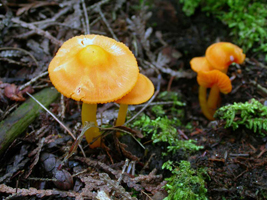 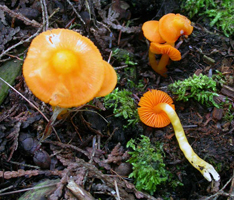
Grows scattered to gregariously on soil in woods
Cap – 1 to 3.5cm, broadly conic to convex, bright orange with darker orange broad umbo, smooth, slightly tacky, hygrophanous
Gills – adnate to sinuate, brilliant orange, sub-distant, broad, sometimes slightly intervenose; gills remain bright orange even as the cap dries and fades
Flesh – thin, pale yellow
Spore print – white
Spores – elliptical, smooth, non-amyloid, 6-9x4-6 microns
Found from mid-summer to fall; also seen at Newport State Park, Whitefish Dunes State Park and Rock Island State Park |
Hygrocybe miniata (Hygrophoraceae) Miniature Waxy Cap
 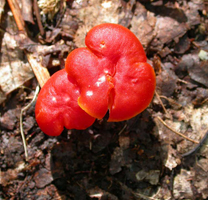 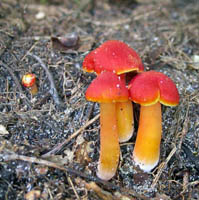
Grows scattered to gregarious on soil, grass or moss
Cap – 1 to 3.5 cm, hemispheric to broadly convex, red to deep orange-red fading to orange in age, center sometimes concave in age, finely striate margins, smooth to finely scaly
Gills – Short-decurrent, orange, sub-distant, broad
Flesh – White to pale orange-yellow, thin
Stalk – 3 to 7 cm by 3 to 9 mm, terete in cross-section, deep orange apex, narrower white base, smooth, hollow
Spore print – White
Spores – 7-10 x 3.5-5.5 microns, elliptical to fat oval, entire, non-amyloid
Comments: This fairly common waxy cap is easy to recognize in the field because of its deep orange gills and dark red cap when fresh. It can be found from late July to early November in warm autumns and has also been seen at the Ridges Sanctuary, Whitefish Dunes State Park, Peninsula State Park and Rock Island. |
Hygrocybe nitida (Hygrophoraceae) Yellow Waxy Cap
 
Grows scattered to gregarious on soil in mixed wood
Cap – 1-4 cm, broadly convex with central depression even in youth, incurved margin, deep to bright yellow, viscid, smooth, fragile
Stem – 3-4 cm by 3-8 mm, central, cylindrical to terete, deep yellow, smooth, viscid to tacky, hollow
Gills – decurrent, bright yellow, sub-distant, broad
Flesh – concolor, thin
Spores – white, non-amyloid, elliptical, smooth, 6-8 x 5-6 microns
Comments – This appears in August and September and has been seen at Whitefish Dunes State Park, Mink River Preserve and Rock Island. |
Hygrocybe psittacina (Hygrophoraceae) Parrot Waxy Cap
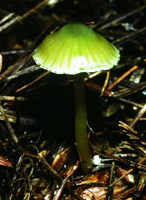
Grows solitary to widely scattered on soil in mixed woods
Cap – 1 to 2.5 cm, deep olive green when very fresh fading to deep yellow in age, bell-shaped to broadly convex, viscid, slightly striate margin
Gills – Thinly decurrent, similar to cap color, sub-distant, moderately broad, thick and waxy
Flesh – Thin, waxy, Concolor
Stalk – 2 to 5 cm by 3 to 4 mm, central, viscid, concolor, tapers upward, hollow
Spore print – White
Spores – 7 x 5 microns, sub-globose to short elliptical, entire
Comments: This species is another easy one to recognize due to its unusual green color and small size. It can be found from mid July to late October and has also been seen at Meridian County Park, Peninsula State Park, Mink River Preserve and The Ridges Sanctuary. It is not common at Toft Point. |
Hygrocybe punicea (Hygrophoraceae) Scarlet Waxy Cap
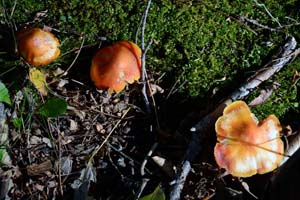 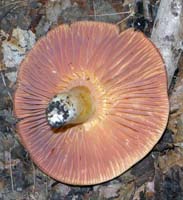
Grows scattered to gregarious on soil in mixed woods
Cap – 3-12 cm, broadly convex to plane, margin slightly uplifted and red, main color is deep red-orange but fades to yellow-orange in age, slippery but not truly viscid, smooth
Stem – 3-9 cm by 1-1.5 cm, central, cylindrical, tapers downward, red-orange to pale orange with white base, smooth, fibrous-striate, pithy to hollow, cartilaginous
Gills – adnexed to sinuate, deep red-orange, sub-distant, very broad, intervenose
Flesh – light orange to yellowish, medium-thick
Spores – white, non-amyloid, elliptical, smooth, 7-11 x 4-6 microns
Comments – This was found in September and October at Newport State Park, Mink River Preserve, Pincha Woods and Rock Island. |
Hygrophoropsis aurantiaca (Paxilaceae) False Chanterelle
 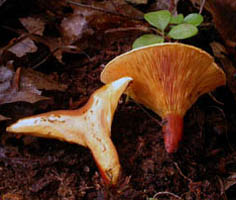 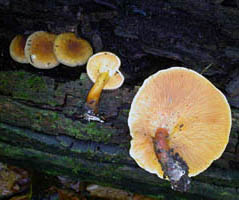
Grows scattered on soil, often in moss, under conifers
Cap – 3 to 6 cm, very broadly convex to flat to funnel-shape in age, deep orange to orange-brown disk, bright yellow-orange margin, turns darker brown when aged, smooth
Gills – Decurrent, brilliant orange, blunt-edged, close, forked repeatedly, broad
Flesh – Dull orange-brown, medium-thick
Stalk – 3.5 to 5 cm by 5 to 9 mm, medium dark brown, widening downward, smooth, pithy to hollow
Spore print – White to buff
Spores – 5-8 x 3-4.5 microns, elliptical, entire, often dextrinoid
Comments: This is one of only a few gilled mushrooms with all gills forked repeatedly. It can be found from late August to mid October and has also been seen at Newport State Park, The Ridges Sanctuary and Whitefish Dunes. |
Hygrophorus agathosmus (Hygrophoraceae) Gray Almond Waxy Cap
 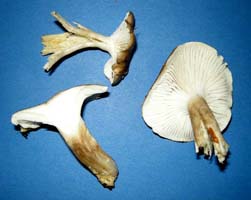
Grows scattered on soil near white pines
Cap – 4-6 cm, very broadly convex, low broad umbo with a few darker spots on it (10X lens), medium-gray-tan, very viscid,
Stem – 4 cm by 1-1.3 cm, central, cylindrical, light gray, paler apex, appressed-fibrillose surface, cartilaginous, pithy to hollow, splits vertically
Gills – short decurrent, white, sub-distant, narrow to medium-broad, partly intervenose
Flesh – white, thick
Spores – white, non-amyloid, elliptical, smooth 9-11 x 5-6 microns
Comments – This was found only once in mid-October at Three Springs Preserve. |
Hygrophorus eburneus (Hygrophoraceae) Ivory Waxy Cap
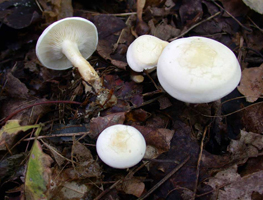 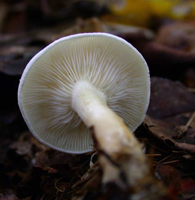  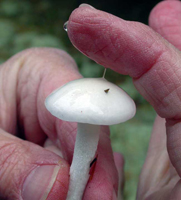
Grows solitary to widely scattered on soil in mixed woods
Cap – 1.5 to 4.5 cm, broadly convex with incurved margin when fresh to flat in age, pure white, viscid to glutinous, non-striate margin, disk may be light yellow in age and margin uplifts
Gills – Adnate to slightly decurrent, white, medium broad, sub-distant
Flesh – White, medium-thick, no odor
Stalk – 3 to 8 cm by 5 to 9 mm at apex to 2 to 5 mm at base, apex white and dotted with beads of moisture, base narrow and smooth-striate, viscid, hollow
Spore print – White
Spores – 6-10 x 4.5-7 microns, elliptical, entire, non-amyloid
Comments: This shining white waxy cap is easy to identify in the field due to its very slimy cap and stalk. Sometimes it is so heavily viscid that it is difficult to handle. It can be found from late August to late October, but never abundant, and has also been seen at The Clearing Folk School, Meridian County Park, Mink River Preserve, Newport Park, Kangaroo Lake TNC Preserve, Rock Island and Whitefish Dunes. |
Hygrophorus fuligineus (Hygrophoraceae) Brown Viscid Waxy Cap
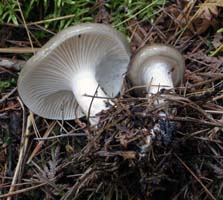 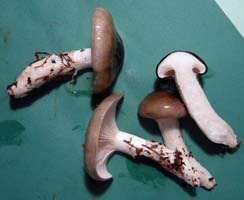 
Grows scattered to gregarious on soil under pines and cedars
Cap – 3-5 cm, convex to broadly convex, rich deep chocolate brown, heavy slime layer on cap, broad darker umbo and paler margin which is incurved in youth
Stem – 3-5 cm by 1-1.5 cm, central, cylindrical, white, slightly thicker in center with taper downward to base, pithy
Gills – decurrent, white, close to sub-distant, medium-broad
Flesh – white, thick
Spores – white, non-amyloid, fat oval, smooth, 7-11 x 4-6 microns
Comments – I remembered finding this in The Ridges Sanctuary in the fall of 1977 and finally found it again on October 14, 2016! I grew on Winter Wren trail in 2016 and on Wintergreen Trail in 1977. |
Hygrophorus fuscoalbus (Hygrophoraceae) no common name
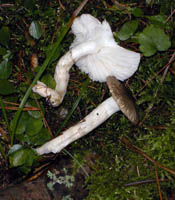 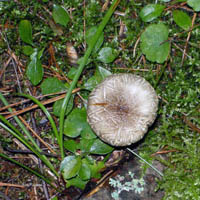 
Grows scattered on soil under conifers
Cap – 2-6 cm, broadly convex to nearly plane with a small umbo, gray-brown, darker center, viscid, smooth
Gills – Short-decurrent, pure white, broad, close to sub-distant
Flesh – White, thick, no odor
Stalk – Central, cylindrical, curved in age, 5-7 cm x 5-10 mm, white, finely powdered, not viscid, pithy to hollow
Spore print – White
Spores – Oval to short elliptical, smooth, non-amyloid, 9-11 x 6-7.5 microns
Comments: Found in October to early November |
Hygrophorus pudorinus (Hygrophoraceae) Spruce Waxy Cup
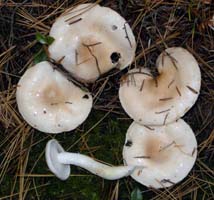 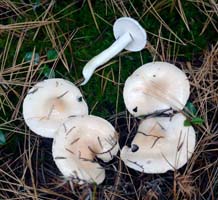
Grows scattered to clustered on soil under conifers
Cap – 3-6 cm, broadly convex with a broad umbo, pinkish tan with darker umbo, margin downcurved in youth and uplifted in age, smooth, very viscid
Stem – 6-9 cm by 9-13 mm, central, cylindrical, tapers downward to a narrow base, very pale tan, apex is shaggy and white, rest is fibrous-striate to smooth, pithy
Gills – adnate to short decurrent, close to sub-distant, pale pink-tan, broad
Flesh – pinkish-white, thick, firm
Spores – white, non-amyloid, fat oval, smooth, 7-9 x 5-6.5 microns
Comments – This is another species I saw in The Ridges Sanctuary long ago. The last record was in early October 1992 then the next time I found it was 10-19-2013! |
Hygrophorus speciosus (Hygrophoraceae) Larch Waxy Cup
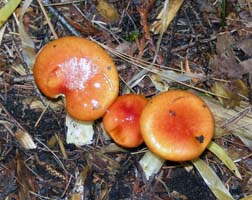 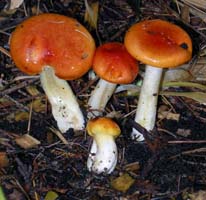
Grows scattered to clustered on soil under conifers
Cap – 2-4 cm, very broadly convex to plane, deep orange to red-orange on disk, smooth, viscid, margin downcurved
Stem – 4-5.5 cm by 7-14 mm, tapers upward, pale yellow, viscid, fibrous-striate, tough, pithy
Gills – decurrent, sub-distant, pale yellow, broad
Flesh – pale yellow, medium-thick
Spores – white, non-amyloid, elliptical, smooth, 7-9 x 5 microns
Comments – Here is another species first seen at The Ridges Sanctuary in the mid-1970’s. It was finally found again on Wintergreen Trail in mid-October of 2013. |
Hypholoma coronatum (Strophariaceae) no common name
 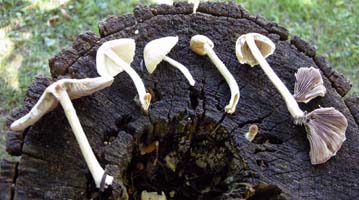  
Grows scattered to gregarious on old rotting hardwood stumps and logs
Cap – 2-7 cm, hemispheric to broadly convex, milk chocolate brown to yellow-brown, smooth to minute granules on disk, delicate partial veil hangs from cap margin, hygrophanous, pale tan in age when dried
Stem – 4-8 cm by 2-7 mm, central cylindrical, pale tan to off-white, fibrous-striate, brittle-cartilaginous, hollow
Gills – adnate, dark brown, close, broad
Flesh – white to tan, thin
Spores – Oreo cookie brown, elliptical, smooth, 6-7.5 x 4-5 microns, no apical pore seen
Comments – The only times I have seen this were July to October of 2014 and again in 2016 in our front yard on and around a rotting basswood log. Some old texts refer to this as Agaricus coronatus (Fries 1874). Originally all gilled mushrooms were in the genus Agaricus. Now that is reserved for a certain group with dark brown spores and free gills. |
Hypomyces lactifluorum (Hypocreaceae) Lobster Mushroom
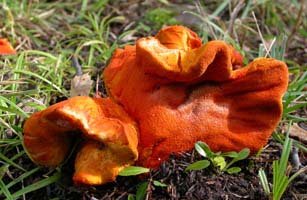 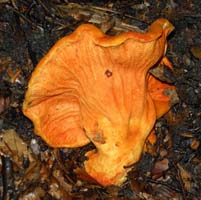 
Grows as a parasite on certain species of Russula or Lactarius totally enclosing and deforming the species underneath
Fruiting body – a bright orange rough to pimpled surface coating the larger, usually white species of Russula or Lactarius
No separate cap, stem or gills
Spores were not studied
Comments – This species can also be golden yellow and always is found on the ground, never on wood. It has been seen in August and September at Logan Creek and Whitefish Dunes State Park. |
Hypsizygus tessulatus (Tricholomataceae) Elm Oyster
 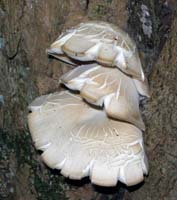 
Grows clustered on dead or dying hardwood trees
Cap – 5-10 cm, convex, pale tan, smooth but surface develops cracks, compact, firm, heavy compared to regular oyster mushroom
Stem – 1-2 cm by 1.2 cm, off-center to lateral, pale tan, solid and sturdy, furry texture
Gills – adnate to adnexed to notched, light tan, close, very broad, edges split in age
Flesh – white, thick, mild odor
Spores – white, non-amyloid, nearly round, smooth, 5-6 microns
Comments – These were found in September and October at Logan Creek and Rock Island. |

